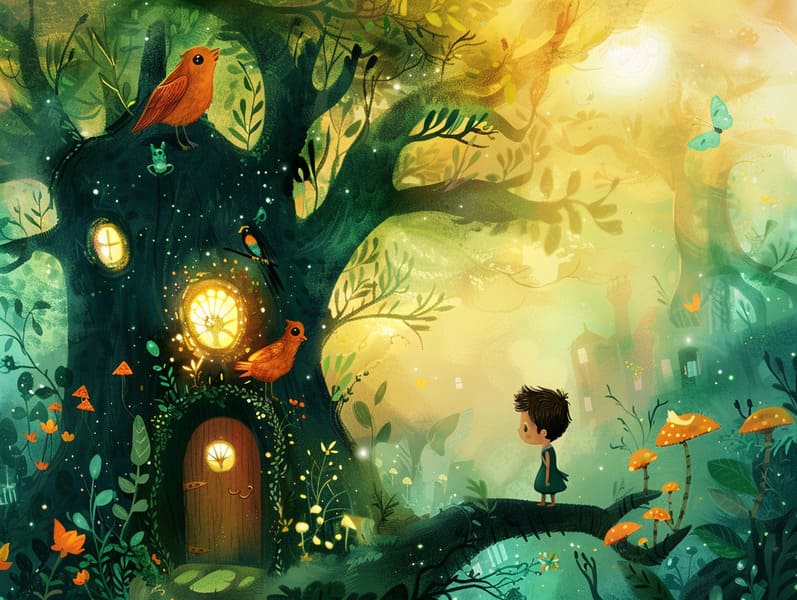
Fairy tales for kids have enduring presence. These stories have been whispered from one generation to the next long before they were ever documented. They sprang from a variety of traditions, including African traditions. They were initially passed along among grown-ups, often carrying themes and messages relevant to the societal norms and beliefs of the time.
The Brothers Grimm, Jacob and Wilhelm, were among the first to compile many of these beloved tales. Their anthology, "Grimm's Fairy Stories," included stories like "The Little Glass Slipper," "The Story of Hansel and Gretel," and "Schneewittchen," which have since become classics in the world of children's fairy tales. Similarly, Andersen's charming fairy tales, such as "The Mermaid," and "The Duckling's Story," have gained the love worldwide, ensuring their place in the pantheon of timeless fairy tales.
Though they are centuries old, fairy tales remain as pertinent as ever, especially as children's bedtime stories. These delightful tales are now available in various formats, including artistically illustrated books, captivating animations, and digital storybooks.
Their enduring popularity can be traced to several charming aspects:
Ethical Lessons: Timeless fairy tales often convey important moral lessons. Tales like "The Shepherd Boy and the Wolf" teach the significance of truthfulness, while "The Story of the Tortoise and the Hare" emphasize the qualities of determination and humility. These narratives offer little ones clear distinctions between truth and falsehood, building their moral compass in a gentle yet significant way.
Compassion and Insight: Timeless fairy tales frequently present personalities facing challenges and problems, stimulating children to comprehend with their struggles and applaud their triumphs. For instance, "Beauty and the Beast" teaches us the merit of seeing inner beauty to recognize the real character of a individual, advancing insight and awareness.
Cultural Awareness: Many classic fairy tales are infused with the cultural contexts from which they sprang. Engaging with these fairy tales can provide captivating looks into different heritages, advancing a sense of world awareness and respect.
Creativity and Fantasy: The magical elements in classic fairy tales—enchanted objects—fuel children’s fantasies. These stories transport readers to otherworldly realms, motivating innovative dreams and a sense of excitement that remains a lifetime.
Ancient fairy tales are not only charming but also edifying. They provide fascinating tools in nurturing various intellectual and emotional capacities in little ones. When old fairy tales are spoken, they foster verbal development by showing new phrases and intricate sentence structures. This practice also fosters auditory skills and attention span, as the young follow the story, enthusiastic to see what happens next.
Furthermore, contemplating the themes and characters of timeless fairy tales can advance problem-solving abilities and reasoning skills. Little ones are taught to identify patterns, anticipate outcomes, and make sense of cause and effect. These discussions also benefit young readers articulate their thoughts and feelings, contributing to their emotional intelligence.
In today’s modern era, the presence of digital fairy tales has made these narratives more obtainable than ever. Web platforms and digital apps present wide arrays of ancient fairy tales that can be browsed or played anytime, anywhere. Fairy tales voiced are particularly common, featuring an charming way for young readers to experience these bewitching tales. Audio stories and spoken videos move characters and settings to life, often accompanied by fantastical background sounds and tunes that enhance the tale experience.
The unfading fascination of old fairy tales lies in their ability to adapt to the present while continuing with their central messages. Contemporary reimaginings of these fairy tales often feature more varied characters and modern settings, making them meaningful to today’s audience. However, the central morals of braveness, charity, and justice remain unchanged, continuing to influence young readers of all ages.
Ancient fairy tales also offer a sense of contentment and recognition. They provide a structured narrative with a obvious beginning, middle, and end, often concluding with the closure of conflicts and the triumph of goodness over badness. This regularity can be relieving for kids, affording a sense of sturdiness in an shifting world.
Traditional fairy tales continue to delight and coach new generations, maintaining their mystique and pertinence in modern society. As bedtime stories for kids, they showcase a perfect blend of delight and instruction, nurturing moral values, empathy, and creativity. The abundance of internet fairy tales and the commonness of fairy tales told out loud assure that these classic tales remain accessible to new generations.
By maintaining and sharing these fairy tales, we continue to awesome site admire the rich tapestry of myths and cultural heritage. Whether you are perusing a vividly illustrated book, accessing a online library, or listening via an voice book, the elegance of traditional fairy tales is always within reach. These narratives illustrate of the endless effect of tales and its ability to unite us across generations and cultures.
Whether you are seeing a vividly illustrated book, seeing a web-based collection, or hearing an audio story, the captivation of timeless fairy tales is always within reach.
These fairy tales highlight of the ageless influence of storytelling and its ability to hold us together across centuries and lands, casting a charm that enchants and educates alike.